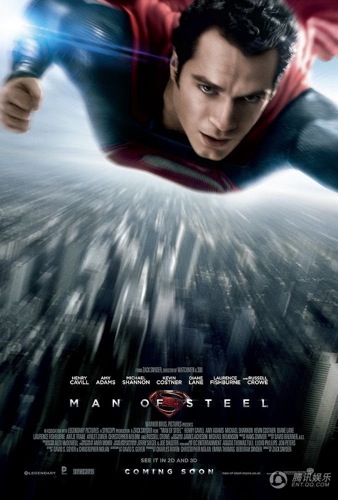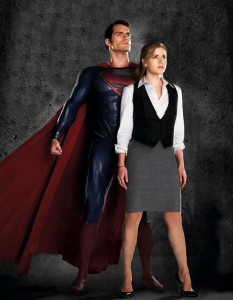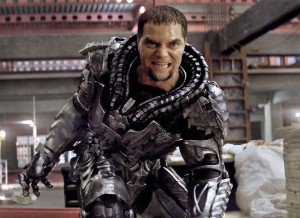 I don’t pay a lot of attention to press kit material, but a quote from director Zack Snyder in the Man of Steel notes bears repeating. “We knew the action had to be bigger than big, with heart-pounding, edge-of-your-seat thrills. We never lost sight of the fact that we were making a Superman movie.” His producer wife, Deborah, chimes in on their goal: “To make Superman relevant for today’s audiences, to make him fit into our world.”
I don’t pay a lot of attention to press kit material, but a quote from director Zack Snyder in the Man of Steel notes bears repeating. “We knew the action had to be bigger than big, with heart-pounding, edge-of-your-seat thrills. We never lost sight of the fact that we were making a Superman movie.” His producer wife, Deborah, chimes in on their goal: “To make Superman relevant for today’s audiences, to make him fit into our world.”
“Mission accomplished“–as a former president once said of some business that turned out to be rather incomplete. On its own terms, Man of Steel is a success, an update of 75-year-old comics mythology free of the “truth, justice, all that stuff” ambivalence of the only fitfully fulfilling Superman Returns (2006). It knows what it wants to be, and owns it. But it’s the latest in a lengthening line of superhero and sci-fi/action adventure blockbusters (many, like this one, produced by the deep-pocketed Legendary Pictures) to leave me queasy.
Beginning with the birth agonies of Lara Lor-Van (Ayelet Zurer), wife of scientist Jor-El (Russell Crowe), on the dying planet Krypton, Man of Steel dispenses with the four-panel lightness, urbane wit, and heartfelt romantic comedy of the Richard Donner/Richard Lester epoch of Superman: The Movie (1978) and Superman II (1981) to bring Superman into “our world”–one of pain, suspicion, and darkness. Thanks to producer Christopher Nolan, whose wildly popular Dark Knight trilogy dictated that black be the new color for superheroes, everyone suffers, or at least droops, in the gray- and brown-toned hues of cinematographer Amir Mokri, which render the famed red cape a deep burgundy. Jor-El and Lara lose their naturally conceived son, a rebuke to the dynastic, genetically pure bloodlines of Krypton, within minutes of his birth, and Jor-El his life to the fearsome warrior General Zod (Michael Shannon), whose life is dedicated to preserving the Kryptonian life and ways. Zod and his minions, numbering the feral Faora-Ul (Antje Traue), are exiled to a “somatic cleansing” version of the Phantom Zone. Krypton, strip-mined out of existence, explodes, as Hans Zimmer’s droning fanfares struggle to emerge from the thunderous sound mix. Only 123 more minutes to go.
 Here this disguised origins story splinters for some time into flashbacks, as experienced by the 33-year-old (hmm) Clark Kent (Henry Cavill), who, enroute to the Arctic to uncover his destiny, performs anonymous good deeds. It’s not been a wonderful life for the Smallville resident, thick with bullying and evasion, as he hides the true extent of his Krypton-derived superpowers on the counsel of Ma (Diane Lane) and Pa Kent (Kevin Costner), going so far as to stand down when Pa faces a threat depicted with Old Testament furor. In a nice switch from the same old that works (and some of this rethink does), the intrepid Lois Lane (Amy Adams), investigating a mysterious craft in the icy climes under the wary eyes of the US military, immediately deduces that the handsome stranger she meets in a crevasse is the alien visitor she’s tracking for the skeptical Daily Planet. But there’s no time to waste on night flights over the poles and other falling-in-love fancies–Zod, freed from confinement by the shock wave generated by the collapse of Krypton, has found the son of his frenemy, and is determined to use him in his plan to remake Krypton on Earth.
Here this disguised origins story splinters for some time into flashbacks, as experienced by the 33-year-old (hmm) Clark Kent (Henry Cavill), who, enroute to the Arctic to uncover his destiny, performs anonymous good deeds. It’s not been a wonderful life for the Smallville resident, thick with bullying and evasion, as he hides the true extent of his Krypton-derived superpowers on the counsel of Ma (Diane Lane) and Pa Kent (Kevin Costner), going so far as to stand down when Pa faces a threat depicted with Old Testament furor. In a nice switch from the same old that works (and some of this rethink does), the intrepid Lois Lane (Amy Adams), investigating a mysterious craft in the icy climes under the wary eyes of the US military, immediately deduces that the handsome stranger she meets in a crevasse is the alien visitor she’s tracking for the skeptical Daily Planet. But there’s no time to waste on night flights over the poles and other falling-in-love fancies–Zod, freed from confinement by the shock wave generated by the collapse of Krypton, has found the son of his frenemy, and is determined to use him in his plan to remake Krypton on Earth.
Here I part ways with Man on Steel. I can’t say I was having a good time with it before Zod’s onslaught; “fun” isn’t part of the Nolan, or Snyder, aesthetic (if there was a laugh in the Snyder-directed Dawn of the Dead, 300, or Watchmen, I must have missed it as I cowered in my seat). But I was absorbed by the changes, large and small, to the established mythos, the little call-outs to the Supes of yore (handled much less self-consciously than in Returns), and the occasional grace notes, like Lane gently talking the boy Clark out of a schoolhouse dilemma. I didn’t mind that David S. Goyer’s screenplay, which Nolan had a hand in, was accumulating incidents, the more actionful the better, at the expense of character development and some sort of emotional throughline. I figured that would come, now that Lois and the subject of her “super” story had met.
Wrong.
 Where did the terrorists win after 9/11? At the boxoffice. I’d put the summer of 2005, with Nolan’s Batman Begins and Steven Spielberg’s War of the Worlds, as the start of a wave of movies that weave 9/11 issues and imagery, sometimes thoughtfully, sometimes exploitatively, into their storylines. It doesn’t always bug me; Iron Man 3 found satiric humor in the cultivation of terrorism and the advance of the surveillance state. Man of Steel, though, is wanton, and I write this as someone usually unoffended by onscreen urban chaos. Once Superman is summoned by Zod (in an eerie, quiet sequence, one of the movie’s strongest), he is thrust into wholesale carnage that none of his abilities can solve, as the general, having laid waste to Smallville, erects planet-smashing devices in Metropolis and the Indian Ocean and attempts to grind the world into submission. “That was sick,” my wife, who fled the collapse of the Twin Towers on Sept. 11, said afterwards, following the fall of skyscraper after skyscraper after skyscraper–and, once the last shard of glass seemed to have broken, the start of another city-wasting dustup, during which Superman finally gets mad. Man of Steel goes well beyond comment, or catharsis, into all-out 9/11 destruction porn, a sodden, dispiriting spectacle far removed from the simple, ever-“relevant” pleasures of comic books and this particular hero. Snyder and Nolan aren’t the first filmmakers to get drunk on the possibilities of digital effects to masturbate the rabble that presumably oohs and ahhs over this sort of thing, but I thought they were sharper than this. Contrary to his aims, Snyder hasn’t made a Superman movie; he’s made a Zod one, and no wonder that character, ferociously played by Shannon, is more vivid than the pleasant, if largely unsmiling, Cavill, or Adams, an effortlessly enchanting presence at odds with all that hardware and firepower.
Where did the terrorists win after 9/11? At the boxoffice. I’d put the summer of 2005, with Nolan’s Batman Begins and Steven Spielberg’s War of the Worlds, as the start of a wave of movies that weave 9/11 issues and imagery, sometimes thoughtfully, sometimes exploitatively, into their storylines. It doesn’t always bug me; Iron Man 3 found satiric humor in the cultivation of terrorism and the advance of the surveillance state. Man of Steel, though, is wanton, and I write this as someone usually unoffended by onscreen urban chaos. Once Superman is summoned by Zod (in an eerie, quiet sequence, one of the movie’s strongest), he is thrust into wholesale carnage that none of his abilities can solve, as the general, having laid waste to Smallville, erects planet-smashing devices in Metropolis and the Indian Ocean and attempts to grind the world into submission. “That was sick,” my wife, who fled the collapse of the Twin Towers on Sept. 11, said afterwards, following the fall of skyscraper after skyscraper after skyscraper–and, once the last shard of glass seemed to have broken, the start of another city-wasting dustup, during which Superman finally gets mad. Man of Steel goes well beyond comment, or catharsis, into all-out 9/11 destruction porn, a sodden, dispiriting spectacle far removed from the simple, ever-“relevant” pleasures of comic books and this particular hero. Snyder and Nolan aren’t the first filmmakers to get drunk on the possibilities of digital effects to masturbate the rabble that presumably oohs and ahhs over this sort of thing, but I thought they were sharper than this. Contrary to his aims, Snyder hasn’t made a Superman movie; he’s made a Zod one, and no wonder that character, ferociously played by Shannon, is more vivid than the pleasant, if largely unsmiling, Cavill, or Adams, an effortlessly enchanting presence at odds with all that hardware and firepower.
In another fleeting instance of charm, Man of Steel closes with another “birth,” and the promise of a sequel that will strengthen the weak bond between Lois and Clark–and introduce a human-sized menace whose logo can be spotted amidst a sea of product placement. If there is to be a next time, and the filmmakers can ever get over all that tiresomely angst and annihilation, more man, less steel, please.
[youtube width=”602″ height=”350″ video_id=”T6DJcgm3wNY”]




Comments